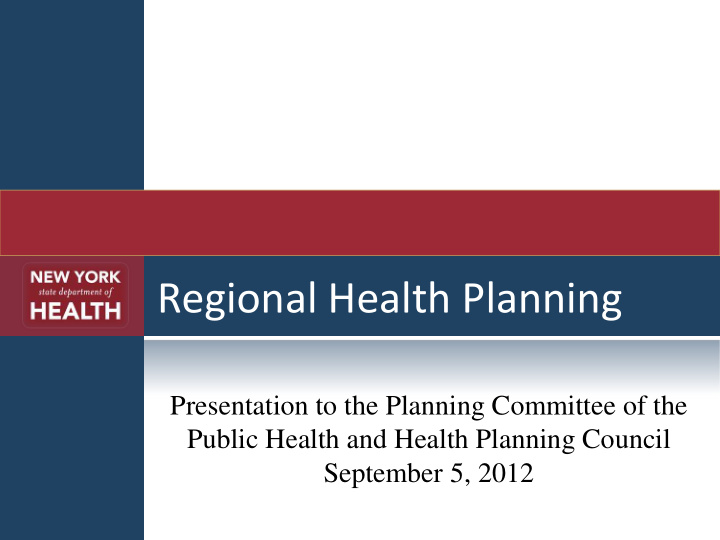



Regional Health Planning Presentation to the Planning Committee of the Public Health and Health Planning Council September 5, 2012
Goals for Meeting Discuss Guiding Principles of Regional Planning Define Core Functions for Regional Planning Discuss Regional Boundaries Discuss Future Planning Role of PHHPC
Why Regional Health Planning? Dramatic changes in the delivery system: Risk-based payment methodologies; New care models; Consolidation of providers and payers; Improved access to health insurance; Emphasis on care coordination, patient engagement, and population health. Renewed attention to population health Availability of data Health status APD Clinical
High-Level Goal: Promoting the Triple Aim Improve the patient experience of care (including quality and satisfaction); Improve the health of the populations; and Reduce the per capita cost of health care.
Guiding Principles Distinguish enterprise planning from community planning Governance: Transparent Neutral Representative Inclusive Collaborative Address Triple Aim Other?
Possible Core Functions Support Community Health Assessments and Advance SHIP: LHD Community Health Assessment Hospital Community Health Needs Assessments Develop and implement strategies to address needs, advance SHIP Measure health system performance on local level
Possible Functions (cont’d) Develop and facilitate effective strategies to address weaknesses, e.g.: Quality collaboratives; Patient engagement activities; Address gaps in services; Reduce preventable utilization; Preserve and strengthen essential providers. Alignment of payment and benefit design with quality and outcome objectives. CONs Waiver and other funding.
Cross-Cutting Functions Evaluation of health and health care disparities; Development of strategies to address disparities; Collection, analysis and dissemination of data; Others?
Data Develop statewide and regional, interactive data mart Based on uniform data set Permits regional comparisons Permits assessment of performance and effectiveness of strategies. Models County rankings NYC DOHMH EpiQuery Dartmouth Atlas
Defining the Regions FACTORS: Regional identity; Health care market considerations; Consistency with other regional initiatives; Planning infrastructure.
Options for Regional Boundaries Option #1: Governor Cuomo’s Regional Economic Development Council Regions Potential Regions: Western New York: Allegany, Cattaraugus, Chautauqua, Erie, Niagara Finger Lakes: Genesee, Livingston, Monroe, Ontario, Orleans, Seneca, Wayne, Wyoming, Yates Southern Tier: Broome, Chemung, Chenango, Delaware, Schuyler, Steuben, Tioga, Tompkins Central New York: Cayuga, Cortland, Madison, Onondaga, Oswego Mohawk Valley: Fulton, Herkimer, Montgomery, Oneida, Otsego, Schoharie North Country: Clinton, Essex, Franklin, Hamilton, Jefferson, Lewis, St. Lawrence Capital Region: Albany, Columbia, Greene, Saratoga, Schenectady, Rensselaer, Warren, Washington Mid-Hudson: Dutchess, Orange, Putnam, Rockland, Sullivan, Ulster, Westchester New York City: Bronx, Kings, New York, Richmond, Queens Long Island: Nassau, Suffolk
Option #2 - Modified Economic Development Regions Potential Regions Western New York: Allegany, Cattaraugus, Chautauqua, Erie, Genesee, Niagara, Orleans, Wyoming Finger Lakes: Livingston, Monroe, Ontario, Seneca, Wayne, Yates Southern Tier: Broome, Chemung, Chenango, Delaware, Schuyler, Steuben, Tioga, Tompkins Central New York: Cayuga, Cortland, Madison, Onondaga, Oswego Mohawk Valley: Fulton, Herkimer, Montgomery, Oneida, Otsego, Schoharie East North Country: Clinton, Essex, Franklin, Hamilton, Warren, Washington West North Country: Jefferson, Lewis, St. Lawrence Capital Region: Albany, Columbia, Greene, Saratoga, Schenectady, Rensselaer Mid-Hudson: Dutchess, Orange, Putnam, Rockland, Sullivan, Ulster, Westchester New York City: Bronx, Kings, New York, Richmond, Queens Long Island: Nassau, Suffolk
Future Planning Role of PHHPC? PHHPC’s planning role in context of regional planning activities: Near term and long term Statewide oversight Need methodologies Other
Recommend
More recommend